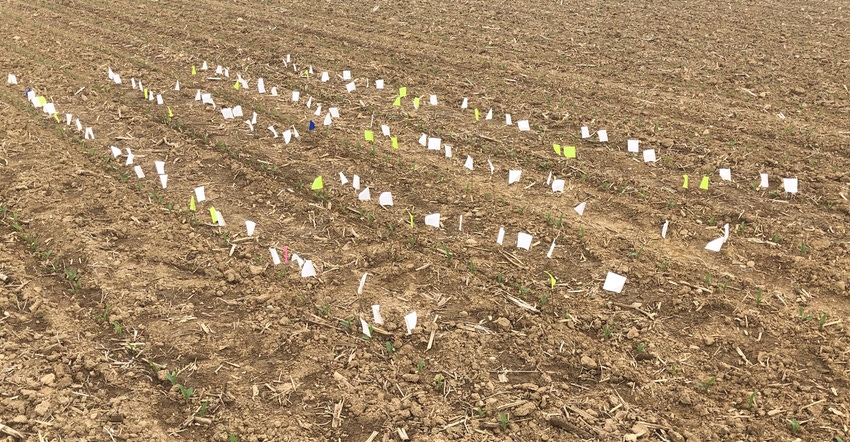
When the history of the 2022 growing season is written, the window beginning around May 10 should be credited with preventing a possible repeat of 2019, when some corn was never even planted. Lots of corn was planted that week. The same period will also be noted for another phenomenon. A stretch of unusually warm to hot days for mid-May resulted in quick germination and emergence for corn.
The Corn Watch ’22 field was planted May 11. Six days later, a few sprigs of green were peeking above the surface, and plenty more were poised just below ground. Seven days after planting, you could almost row the corn by looking.
Related: Corn Watch ’22 field planted on time
Once a set of four rows were staked off — each representing 17 feet, 5 inches, or 1/1,000 acre — emerged corn plants were counted and flagged. This procedure was repeated at a second location within the field. At both locations, about 90% of plants expected to emerge based on seeding rate were already emerged, just seven days after planting.
Here’s one caveat. The operator used variable-rate seeding, with rates in the field varying from 28,000 to 34,000 seeds per acre. Locations haven’t yet been synced back to planting maps, so it’s unclear exactly how many seeds were dropped in both locations. However, by nine days after planting and two days after the first plants emerged, populations in all four rows at both locations were at 32,000 to 36,000 plants per acre.
Put in context
“That’s a dramatic change from one year earlier in an adjoining field, planted with the same planter,” observes Dave Nanda, director of genetics for Seed Genetics Direct. This company sponsors Corn Watch ’22.
The Corn Watch ’21 field was planted on April 25, 2021. The first plants emerged 10 days after planting, but emergence continued for another full two weeks after that. In some rows, nearly half the plants emerged seven days after the first plants in the row were flagged.
What was the difference? The primary difference was weather patterns. In 2021, early May turned very cool and wet soon after the field was planted. Temperatures dipped into the mid-30s for several nights. In 2022, daily highs were in the range of 85 to 89 degrees F for several days after planting, and then leveled out to near normal temperatures.
“Heat makes all the difference,” Nanda says. “If soils are warm and temperatures are also warm, corn can emerge quickly.”
The Purdue University Corn & Soybean Field Guide indicates that corn requires an accumulation of 90 to 120 growing degree days after planting to emerge, and says 115 GDDs is a good, working number for planting to emergence. If the daily high is 85 degrees and the daily low is 60, then 22.5 GDDs would accumulate. A stretch of six such days would generate enough GDDs for emergence.
“You usually don’t get that much heat in mid-May, but we did this year,” Nanda says. “It will be interesting to see what the rest of the season holds after the fast start for mid-May corn.”
About the Author(s)
You May Also Like




